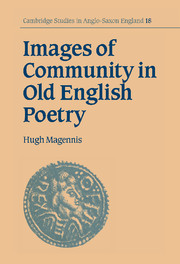Book contents
- Frontmatter
- Contents
- Acknowledgements
- List of abbreviations
- 1 Introduction: ideas of community and an Anglo-Saxon audience/readership
- 2 Hall and city, feasting and drinking: images of communal life
- 3 Hall and feasting in Beowulf
- 4 Hall and feasting: transformations and alternative perspectives
- 5 Personal in conflict with communal
- 6 The mythic landscape of Beowulf: sea, stronghold and wilderness
- 7 The dwelling-places of God's people: place and setting in biblical poetry
- 8 Places of trial and triumph in hagiographical poetry
- 9 Conclusion: community and power in later poetic and other texts
- Bibliography
- Index
8 - Places of trial and triumph in hagiographical poetry
Published online by Cambridge University Press: 14 August 2009
- Frontmatter
- Contents
- Acknowledgements
- List of abbreviations
- 1 Introduction: ideas of community and an Anglo-Saxon audience/readership
- 2 Hall and city, feasting and drinking: images of communal life
- 3 Hall and feasting in Beowulf
- 4 Hall and feasting: transformations and alternative perspectives
- 5 Personal in conflict with communal
- 6 The mythic landscape of Beowulf: sea, stronghold and wilderness
- 7 The dwelling-places of God's people: place and setting in biblical poetry
- 8 Places of trial and triumph in hagiographical poetry
- 9 Conclusion: community and power in later poetic and other texts
- Bibliography
- Index
Summary
In common with other aspects of the genre, the general treatment of place and setting in early medieval hagiography is highly conventional. The concern of the hagiographer is not normally with individuality of place any more than it is with individuality of characterization. One Roman city in hagiography is very much like any other; monasteries, rivers, roads and settlements are not individualized. Wilderness retreats of hermit saints recall those of the desert fathers Antony and Paul: the oriental features of such dwelling-places – the palm trees, the spring of cold water in the desert – are not taken over by western writers but the details of the rocky mountain, of the saint tilling a plot of ground to grow a few crops and of the troublesome birds and beasts which steal the produce become recurrent features of the eremitic tradition.
Attention to the setting of the hermit's dwelling-place presents a conventional theme of the vita of the hermit saint. In the confrontational form of the passzo, however, there is no interest in the physical setting of the saint's martyrdom, which takes place in a location without acknowledged topography and without significant climate or weather. The passio characteristically begins with a highly specific reference to the period and place of the events described and with a careful introduction to the dramatis personae, but when the narrative gets under way the focus moves in on the timeless and placeless confrontation between Christian hero and heathen persecutor.
- Type
- Chapter
- Information
- Images of Community in Old English Poetry , pp. 168 - 188Publisher: Cambridge University PressPrint publication year: 1996



